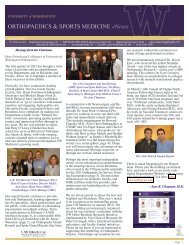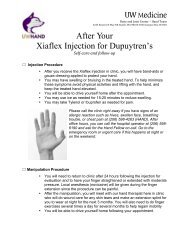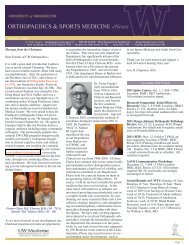Ream and Run for Shoulder Arthritis: Conservative Reconstructive ...
Ream and Run for Shoulder Arthritis: Conservative Reconstructive ...
Ream and Run for Shoulder Arthritis: Conservative Reconstructive ...
Create successful ePaper yourself
Turn your PDF publications into a flip-book with our unique Google optimized e-Paper software.
<strong>Shoulder</strong> & Elbow Service, University of Washington Department of Orthopaedics <strong>and</strong> Sports Medicine<br />
Once A <strong>Shoulder</strong> With <strong>Ream</strong> <strong>and</strong> <strong>Run</strong> Procedure Has Successfully Completed The<br />
Rehabilitation Program, What Activities Are Permissible?<br />
Once the shoulder has a nearly full range of motion, strength <strong>and</strong> com<strong>for</strong>t, we impose no limitation<br />
on the activities it can per<strong>for</strong>m. While there are no strict limitations on participation, those<br />
activities that involve impact (chopping wood, contact sports) <strong>and</strong> those that involve heavy<br />
loads (weightlifting) should be resumed gradually to allow the rotator cuff tendons, muscles <strong>and</strong><br />
joint surface to regain their strength <strong>and</strong> flexibility.<br />
What Problems Can Complicate A <strong>Ream</strong> <strong>and</strong> <strong>Run</strong>?<br />
Like all types of shoulder joint replacement, the <strong>Ream</strong> <strong>and</strong> <strong>Run</strong> operation can be complicated<br />
by infection, pain, weakness, stiffness, nerve or blood vessel injury, fracture, instability, component<br />
loosening, <strong>and</strong> anesthetic complications including death. The most common cause of failure<br />
is a patient’s inability to maintain the range of motion achieved at surgery during the healing<br />
period, which can last up to six months after surgery. In our experience to date with over 300 of<br />
these procedures, a few shoulders have required repeat surgery <strong>for</strong> either (a) partial tear of the<br />
subscapularis tendon, (b) stiffness, (c) loosening of the prosthesis, (d) infection, <strong>and</strong> (e) failure<br />
to achieve the desired level of com<strong>for</strong>t leading them to request the insertion of a plastic socket.<br />
How Many <strong>Ream</strong> <strong>and</strong> <strong>Run</strong> Surgeries Are Done At The University Of Washington?<br />
We currently per<strong>for</strong>m 40-50 of these procedures each year on carefully selected patients from<br />
across the United States.<br />
What If The Patient Lives A Long Way Away From Seattle?<br />
Patients often come to Seattle from a long distance <strong>for</strong> this procedure. You can begin the process<br />
by contacting the <strong>Shoulder</strong> <strong>and</strong> Elbow Clinic at (206) 598-4288 <strong>and</strong> asking a staff member<br />
to guide your next steps. Alternatively you can email Dr. Matsen at matsen@uw.edu. If you<br />
wish, we can make a tentative ‘one stop’ plan in which we consider per<strong>for</strong>ming the evaluation<br />
<strong>and</strong> the surgery in the same week, if all systems are go. We are available by appointment in<br />
the <strong>Shoulder</strong> <strong>and</strong> Elbow Clinic, 4245 Roosevelt Way N.E. Seattle, on Mondays <strong>and</strong> Fridays to<br />
evaluate individuals with shoulder arthritis to discuss the procedures that might be most ideally<br />
suited <strong>for</strong> them. We per<strong>for</strong>m surgery on Tuesdays <strong>and</strong> Wednesdays at the University of Washington<br />
Medical Center, 1959 NE Pacific St, Seattle, Washington, 206 598-4288.<br />
Patients having a <strong>Ream</strong> <strong>and</strong> <strong>Run</strong> procedure are usually able to be discharged from the medical<br />
center/hospital in two days <strong>and</strong> return home in three to four days after the procedure able to<br />
return home three to four days after the procedure, assuming they have mastered their exercises<br />
<strong>and</strong> have reasonable com<strong>for</strong>t on reasonable medications. The staples used to close the<br />
skin can be removed by a nurse or physician near the patient’s home. Ideally, we like to see<br />
patients back at six weeks after surgery to assure that satisfactory progress is being made.<br />
We request that patients complete questionnaires at 3, 6, 12, 18 <strong>and</strong> 24 months after surgery<br />
so we can track their progress <strong>and</strong> that the patient obtain <strong>and</strong> send to us X-rays at 12 <strong>and</strong> 24<br />
months after surgery if they are unable to return to Seattle <strong>for</strong> the annual follow-ups. All patients<br />
have our personal email <strong>and</strong> the clinic contact phone numbers to use in contacting us at<br />
any time questions arise.















